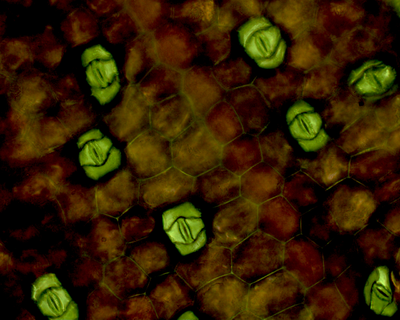Difference between revisions of "Stoma"
(Created page with "==Key Stage 3== ===Meaning=== '''Stomata''' are holes in the leaf that can open and close to allow or stop gas exchange in the leaf. : Sing...") |
(→About Stomata) |
||
| Line 24: | Line 24: | ||
: 6. [[Respiration]] continues to make [[water]] and [[water]] is taken up by the [[root]]s. | : 6. [[Respiration]] continues to make [[water]] and [[water]] is taken up by the [[root]]s. | ||
: 7. [[Plant]] becomes [[hydrated]] again. | : 7. [[Plant]] becomes [[hydrated]] again. | ||
| − | : 8. [[Guard | + | : 8. [[Guard Cell]]s become [[turgid]]. |
: 9. [[Stomata]] open. | : 9. [[Stomata]] open. | ||
: 10. [[Carbon Dioxide]] can now get into the [[leaf]]. | : 10. [[Carbon Dioxide]] can now get into the [[leaf]]. | ||
: 11. [[Photosynthesis]] starts again using up the [[water]]. | : 11. [[Photosynthesis]] starts again using up the [[water]]. | ||
Revision as of 10:22, 18 September 2018
Key Stage 3
Meaning
Stomata are holes in the leaf that can open and close to allow or stop gas exchange in the leaf.
| The under side of a leaf showing guard cells and stomata. |
About Stomata
- There are usually more stomata on the underside of a leaf than the top side.
- Stomata close when the leaf becomes dehydrated. This stops photosynthesis, which needs water, so it helps stop the dehydration from getting worse.
The Process:
- 1. Plant becomes dehydrated.
- 2. Guard Cells become flaccid.
- 3. Stomata close.
- 4. Carbon Dioxide can no longer enter the leaf.
- 5. Photosynthesis stops.
- 6. Respiration continues to make water and water is taken up by the roots.
- 7. Plant becomes hydrated again.
- 8. Guard Cells become turgid.
- 9. Stomata open.
- 10. Carbon Dioxide can now get into the leaf.
- 11. Photosynthesis starts again using up the water.
